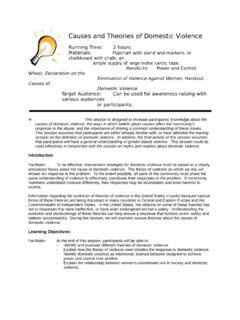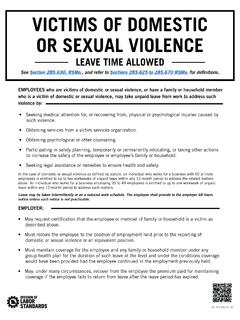Transcription of Intimate partner violence and alcohol
1 W H O FA C T S O N . +. alcohol . violence . Intimate partner violence and alcohol Intimate partner violence refers to any behaviour within an Intimate relationship that causes physical, psychological or sex- . ual harm to those in that relationship. It includes acts of physical aggression (slapping, hitting, kicking or beating), psychological abuse (intimidation, constant belittling or humiliation), forced sexual inter- . course or any other controlling behaviour (isolating a person from family and friends, monitoring their movements and restricting access to information or assistance) (1). alcohol consumption, especially at harmful and hazardous levels is a major contributor to the occur.
2 Rence of Intimate partner violence and links between the two are manifold. This fact sheet details what is known about the role of alco- . hol in shaping the extent and impact of Intimate partner violence , factors that increase the risk of becoming a victim or perpetrator, and the role of public health in prevention. Harmful use is defined as a pattern of alcohol use that causes damage to health. Hazardous use is defined as a pattern of alcohol use that increases the risk of harmful consequences for the user (World Health Organization, who_ lexicon/en/). 1. Links between alcohol use and Intimate partner violence Strong links have been found between alcohol use and the occur.
3 Rence of Intimate partner violence in many countries. Evidence suggests that alcohol use increases the occurrence and severity of domestic violence (6,7,8). alcohol consumption as a direct cause of Intimate partner violence has often been contested (9) either on the basis of additional factors ( low socio- economic sta- . tus, impulsive personality) accounting for the presence of both, or because frequent heavy drinking can create an unhappy, stressful partnership that increases the risk of conflict and violence . How- . ever, evidence is available to support relationships between alcohol and Intimate partner violence that include: alcohol use directly affects cognitive and physical function, reducing self-control and leaving individuals less capable of negotiating a non-violent resolution to conflicts within relation.
4 Ships (10). Excessive drinking by one partner can exacerbate financial dif- . ficulties, childcare problems, infidelity (11) or other family BOX 1: Extent of Intimate partner violence Most reported Intimate partner vio- studies to report comparable data, lence is perpetrated by men towards shows that between 15% ( Japan) and women (1). However, violence is also 71% (Ethiopia) of women reported committed by women towards men experiencing physical and sexual vio- . (2) and within same sex relationships lence by an Intimate partner over their (3). Variations in methodologies and lifetime, and between (Japan). definitions of violence between sur- and 53% ( Ethiopia) as experiencing veys make the extent of Intimate part- such violence within the past year.
5 In ner violence and differences between a survey of 24,000 men and women countries hard to estimate. How- in Canada, 7% of women and 6% of ever, the WHO multi-country study on men reported having been victims of women's health and domestic violence Intimate partner violence in the last against women (4), one of the few five years (5).. stressors. This can create marital tension and conflict, increas- . ing the risk of violence occurring between partners (12). Individual and societal beliefs that alcohol causes aggression can encourage violent behaviour after drinking and the use of alcohol as an excuse for violent behaviour (13).
6 Experiencing violence within a relationship can lead to alcohol consumption as a method of coping or self-medicating (14). Children who witnesses violence or threats of violence between parents are more likely to display harmful drinking patterns later in life (15). Magnitude of alcohol -related Intimate partner violence Studies of Intimate partner violence routinely identify recent con- . sumption of alcohol by perpetrators. Estimates vary between countries. In the United States of America, and in England and Wales, victims believed their partners to have been drinking prior to a physical assault in 55% (16) and 32% (17) of cases respec.
7 Tively. In Australia, 36% of Intimate partner homicide offenders were under the influence of alcohol at the time of the incident (18), while in Russia, of such offenders were intoxicated (19). In South Africa, 65% of women experiencing spousal abuse within last 12 months reported that their partner always or sometimes used alcohol before the assault (20). Other countries where strong links between perpetrator drinking and Intimate partner vio- . lence have been found include India (21), Uganda (22), Vietnam (12), and Zimbabwe (23). Furthermore, a multi- country study in Chile, Egypt, India and the Philippines identified regular alco.
8 Hol consumption by the husband or partner as a risk factor for any lifetime physical Intimate partner violence across all four study countries (24). alcohol consumption in victims of Intimate partner violence has also been shown, although at a lower level than in perpetrators. alcohol use was categorised as: non-drinker, drink but not to excess, occasional drinker and regular drinker, although categories were not defined further.. For example, a Swiss study indicated that victims had been under the influence of alcohol in over 9% of incidents of Intimate part- . ner violence (compared with 33% of perpetrators) (25), while in Iceland, 22% of female domestic violence victims reported using alcohol following the event as a mechanism for coping (26).
9 Risk factors for alcohol -related Intimate partner violence A number of individual, relationship and societal factors can exac- . erbate the association between alcohol use and violence . For perpetrators, heavier, more frequent drinking increases the risk of violence (27,28), and there is some evidence that problem drinkers are at increased risk of victimization (28). Having only fair or poor mental health has been found to co-occur with problematic alcohol use as a risk factor for violent offending (29), and heavy drinking is more strongly associated with severe Intimate partner violence among men with antisocial personality disorder (30).
10 Having an expectation that drinking alcohol will lead to aggressive behaviour increases the risk of committing violence towards a partner (13), while relationship dissatisfaction can strengthen the links between problem drinking and partner violence (the USA) (31). Some evi- . dence suggests that differences in alcohol consumption between partners are also important and couples where only one partner drinks excessively are more likely to experience alcohol -related arguments and physical violence (the USA) (32). Societal beliefs about alcohol consumption, gender roles and vio- . lent behaviour can also affect the risk of alcohol -related partner violence .














